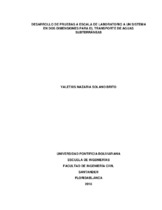Mostrar el registro sencillo del ítem
Desarrollo de pruebas a escala de laboratorio a un sistema en dos dimensiones para el transporte de aguas subterráneas
| dc.contributor.advisor | Director. Forero Sarmiento, Juan Carlos | |
| dc.contributor.author | Solano Brito, Yaletxis Nazaria | |
| dc.coverage.temporal | 2019 | |
| dc.date.accessioned | 2020-10-21T21:17:12Z | |
| dc.date.available | 2020-10-21T21:17:12Z | |
| dc.date.issued | 2019-01 | |
| dc.identifier.uri | http://hdl.handle.net/20.500.11912/6193 | |
| dc.description | 63p.: (pdf); il; imágenes; gráficas; tablas; anexos. | spa |
| dc.description.abstract | El agua subterránea es un recurso bastante significativo en la vida cotidiana, al cual no se le da la importancia que merece. Muchas personas consideran a las aguas subterráneas como un fenómeno raro, que generalmente asocian con un mero pozo del que extraen agua a través de un balde sujetado a una cuerda. Pero lo que muchos desconocen, es que el agua subterránea es más que eso, ya que gracias a este recurso se mantiene el caudal de muchos ríos cuando duran largos periodos sin llover. Por esta razón, se vio la necesidad de realizar una investigación sobre los fenómenos de movilidad del agua, a fin de buscar estrategias de enseñanza y aprendizaje en las áreas de hidrología y mecánica de suelos para los estudiantes de la Facultad de Ingeniería Civil de la Universidad Pontificia Bolivariana, Seccional Bucaramanga. Para cumplir con las expectativas de este proyecto, se utilizó un modelo existente, el cual fue construido por los estudiantes de semillero. A fin de realizar pruebas para determinar las condiciones hidráulicas necesarias para simular un flujo de aguas subterráneas, así como también conocer la conductividad hidráulica en el sistema y por medio de un conductímetro, evaluar cómo se presenta la dispersión de salinidad en el mismo. Esto con la intención de brindarle a los estudiantes la capacidad de adquirir competencias a escala de laboratorio, las cuales a futuro podrán ser extrapoladas a escala real, es decir, en campo. Después de realizadas todas las pruebas se dedujo que la conductividad hidráulica del sistema es muy rápida. que a mayor cantidad de sales presentes en el agua mayor será la conductividad eléctrica y donde se da mayor saturación de trazado indica que el manto de suelo en ese punto tiene menor velocidad. | spa |
| dc.description.abstract | Groundwater is a very significant resource in everyday life, which is not given the importance it deserves. Many people consider groundwater as a rare phenomenon, which they usually associate with a mere well from which they extract water through a bucket attached to a rope. But what many do not know, is that groundwater is more than that, because thanks to this resource the flow of many rivers is maintained when they last for long periods without rain. For this reason, we saw the need to carry out research on the phenomena of water mobility, in order to seek teaching and learning strategies in the areas of hydrology and soil mechanics for students of the Faculty of Civil Engineering of the University Pontifical Bolivariana, Sectional Bucaramanga. To meet the expectations of this project, an existing model was used, which was built by the seedling students. In order to perform tests to determine the hydraulic conditions necessary to simulate a flow of groundwater, as well as to know the hydraulic conductivity in the system and by means of a conductivity meter, to evaluate how the salinity dispersion is presented in it. This with the intention of giving students the ability to acquire skills at laboratory scale, which in the future can be extrapolated to a real scale, that is, in the field. After all the tests were carried out, it was deduced that the hydraulic conductivity of the system is very fast. that the greater amount of salts present in the water, the greater the electrical conductivity and where there is a greater saturation of the tracing, it indicates that the soil layer at that point has a lower velocity. | eng |
| dc.format.mimetype | application/pdf | |
| dc.language.iso | spa | |
| dc.publisher | Universidad Pontificia Bolivariana | spa |
| dc.rights | Attribution-NonCommercial-NoDerivatives 4.0 International | * |
| dc.rights.uri | http://creativecommons.org/licenses/by-nc-nd/4.0/ | * |
| dc.subject | Aguas subterráneas | spa |
| dc.subject | Laboratorios | spa |
| dc.subject | Hidráulica | spa |
| dc.subject | Simulación | spa |
| dc.title | Desarrollo de pruebas a escala de laboratorio a un sistema en dos dimensiones para el transporte de aguas subterráneas | spa |
| dc.type | Trabajo de grado | spa |
| dc.publisher.department | Escuela de Ingenierías | spa |
| dc.publisher.program | Ingeniería Civil | spa |
| dc.type.hasVersion | publishedVersion | spa |
| dc.description.sectional | Bucaramanga | spa |
| dc.description.degreename | Ingeniero Civil | spa |
Ficheros en el ítem
Este ítem aparece en la(s) siguiente(s) colección(ones)
-
Trabajos de grado [6698]
Monografías, artículos, informes, proyecto de grado


